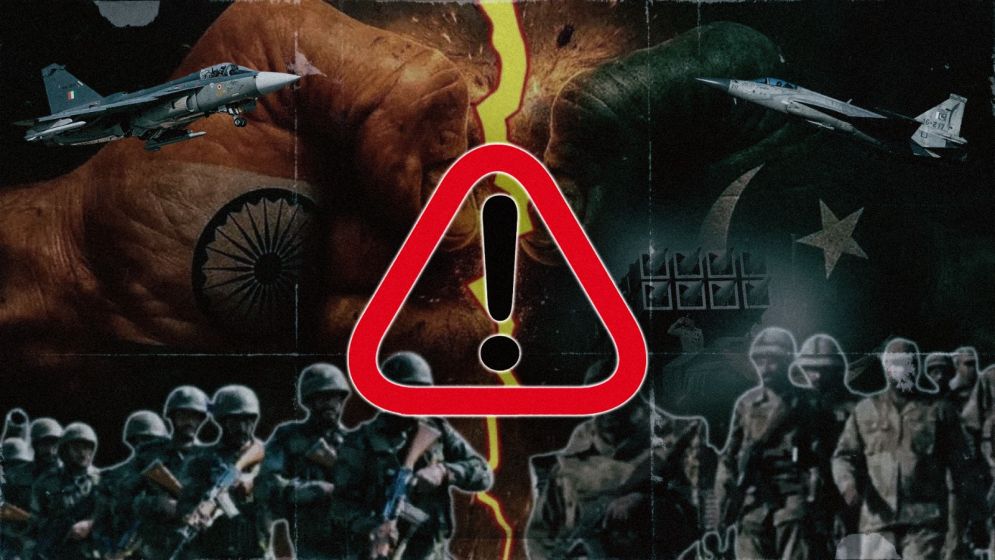India and Pakistan know the script. But what if this time they go off-book…

Early Wednesday morning, Indian jets crossed into Pakistani airspace and launched strikes that instantly rattled a region already laced with tension.
Predictably, fear of war erupted across South Asia. And yes, that fear is justified. But if you’re reading this from Dhaka, or anywhere in the subcontinent, you’d do well to also recognize the cynical choreography playing out.
This isn’t new. What we’re witnessing is textbook “escalation control,” a strategic dance familiar to anyone who’s watched India and Pakistan shadowbox through the decades.
Both sides flex their military muscles just enough to inflame nationalist fervor, but not so far as to invite actual war. Think of it as saber-rattling with the brakes on.
Let’s be clear: these strikes are not essentially about military necessity. They’re probably about political optics.
They are messages–crafted not for the opponent, but for domestic audiences who demand vengeance, strength, and spectacle. The goal? To look tough without doing anything reckless enough to set the region on fire.
India’s own statement probably give the game away. It called the strikes “focused, measured, and non-escalatory”--language so precise it could have been drafted by lawyers, not generals.
New Delhi even went out of its way to note that it deliberately avoided hitting Pakistani military installations.
That’s not restraint born of goodwill. It’s a calculated move to avoid provoking a full-scale Pakistani response.

Familiar pattern
This pattern should be familiar by now.
From Israel’s air raids in Syria to U.S. drone strikes in Yemen, powerful states have mastered the art of limited force–just enough to project dominance, not enough to tip into catastrophe.
South Asia, for all its volatility, is no different.
But while Delhi and Islamabad may be playing an old strategic game, it’s the civilians in Kashmir, Lahore, Amritsar–and yes, even Dhaka–who always bear the risk of miscalculation.
One misstep, one errant missile, and this precarious balance can collapse.
We should not be fooled by talk of restraint. When fighter jets cross sovereign borders, the threshold of peace has already been breached.
What we’re seeing is not just military posturing–it’s a high-stakes gamble, played by leaders who believe they can control the fire they’ve lit.
The rest of us just hope they’re right.
Again, this is not the first time we've seen this kind of tightly calibrated signaling. A textbook example played out in January 2020, when the United States, under President Trump, assassinated Iranian General Qassem Soleimani.
It was, by any measure, a dramatic provocation–one that could have easily triggered full-scale conflict.
Iran, under intense pressure to respond, launched missiles at a U.S. base in Iraq. But the strike was clearly telegraphed in advance. It injured soldiers but caused no deaths.
The message was unmistakable: Iran needed to hit back for the sake of domestic credibility–but it had no interest in dragging the region into another devastating war.
And Washington got the message. Both sides played their part in a pre-scripted performance of controlled rage.
Now, some will claim the U.S.-Iran dynamic isn’t analogous to India and Pakistan. And yes, the histories, arsenals, and alliances are different.
But the logic of escalation control–of calibrated force for the sake of signaling, not war–is nearly identical. The actors may change, but the script remains the same.

What history teaches us
There is precedent closer to home.
After the 2016 Uri attack, in which 19 Indian soldiers were killed, India launched “surgical strikes” across the Line of Control. Pakistan swiftly denied any meaningful damage.
It was denial as de-escalation–a way of absorbing the blow without committing to escalation. In 2019, following the Pulwama suicide bombing that left 40 Indian paramilitary officers dead, India responded with airstrikes on Balakot.
Pakistan retaliated by shooting down an Indian jet, but then returned the captured pilot within days. A gesture of magnanimity? Hardly.
It was a signal–aggression, yes, but bounded by political calculation.
These are of course not isolated moments. They are part of a deeply familiar pattern: states acting not just with missiles, but with messages.
The airstrikes, the statements, the strategic ambiguity–it’s all part of the same geopolitical theater.
That doesn’t mean the fear is misplaced. South Asia is always one miscalculation away from catastrophe.
But the public should understand that what appears to be the edge of war is often a managed spectacle–dangerous, yes, but not entirely unhinged.
The choreography is real. The violence is real. But so is the control.
What we are watching now between India and Pakistan is not the beginning of war. It’s the continuation of a deadly, cynical routine–one that has been rehearsed, refined, and repeated over decades.
And unless something fundamentally changes in the calculus of either side, this is likely how it will continue.
—

